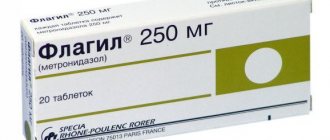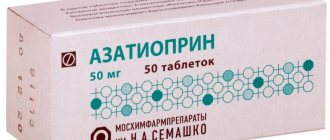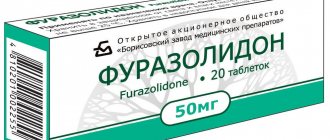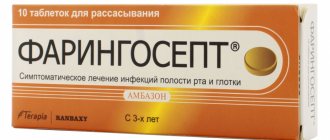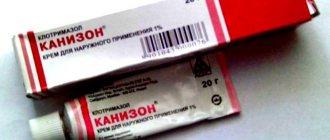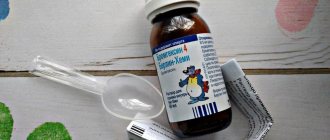Sulfasalazine is prescribed for the treatment of diseases of an autoimmune and inflammatory nature. “Azulfidine” is the main trade name, but on the domestic pharmaceutical market it is represented by medicines with other names. The product has anti-inflammatory and antimicrobial properties. Can be used in children from the age of five. To carry out therapy using this remedy, you need to consult a doctor.
Sulfasalazine is listed on the WHO list of essential medicines.
Therapeutic effect
The active substance is obtained by combining sulfapyridine with salicylic acid. After penetration of the drug into the gastrointestinal tract, aminosalicylic acid is released, which exhibits anti-inflammatory properties. Sulfapyridine is also released in the intestines, which can fight bacterial infection. The combined effect of the drug allows for drug therapy for various diseases.
Package
Basic properties
- Elimination of the inflammatory process. The released aminosalicylic acid plays an important role in the treatment of inflammatory pathologies of the intestines and other organs. The main mechanism of action is due to a disruption in the production of inflammatory mediators in tissues, causing swelling, redness of the mucous membrane and other unpleasant effects. The chemical compound blocks cyclooxygenase and lipoxygenase. The product also exhibits antioxidant activity, neutralizing dangerous forms of oxygen.
- Decreased immune activity. This property is necessary to eliminate autoimmune processes. Sulfapyridine released in the intestines suppresses the functioning of the cellular component of immunity. This effect facilitates the course of rheumatoid arthritis and other diseases with similar pathogenesis.
- Antimicrobial activity. Sulfapyridine fights infectious processes caused by streptococcus, gonococcus and Escherichia coli. The antimicrobial effect is of auxiliary importance, since bacterial pathologies provoke the development of autoimmune reactions.
The anti-inflammatory effect of the drug is better expressed than others.
Pharmacological action of Sulfasalazine
The active component of Sulfasalazine has both anti-inflammatory and antimicrobial effects against pathogens of intestinal diseases.
The use of Sulfasalazine in the treatment of nonspecific colitis is effective due to the ability of the active component of the drug to selectively accumulate in the tissues of the intestinal walls and release acids that have anti-inflammatory activity, as well as have an antimicrobial effect against Streptococcus spp., including Neisseria gonorrhoeae, Streptococcus pneumoniae and Escherichia coli.
Side effects
Some patients experience negative effects while taking the drug. A typical adverse reaction is the body's sensitivity to any component included in the tablets (allergy). To reduce the risk of developing this complication, you need to study your allergic history and monitor your condition during therapy.
Other negative reactions:
- Nervous system: cephalalgia, neuropathy, dizziness, hearing loss, impaired coordination of movements, poor sleep, hallucinations, convulsive reactions.
- Hematopoietic system: deficiency of red blood cells/hemoglobin, decreased levels of leukocytes (including monocytes and granulocytes) and platelets.
- Digestive system: abdominal discomfort, inflammation of the pancreas, lack of appetite, loose stools, inflammation of the liver tissue, vomiting.
- Reproductive system: temporary decrease in the level of male germ cells in the ejaculate, infertility.
- Excretory system: inflammation of the stroma and tubules of the kidneys, disruption of the functioning of the renal tissue.
- Respiratory tract: various forms of damage to lung tissue.
- Immunity: skin rashes, redness of the skin, Lyell's syndrome, Stevens-Johnson syndrome, fever, anaphylactic shock.
- Additionally: yellowishness of the skin, urine and contact lenses during use.
The formation of dangerous allergic complications is possible. If any adverse reactions occur, you should consult your doctor.
Sulfasalazin
A complete clinical blood count, including white blood cell count, red blood cell and platelet counts, and biochemical liver function tests should be performed before starting sulfasalazine and every other week for the first three months of therapy. Over the next three months, the same laboratory tests should be performed monthly, then once every three months and in accordance with clinical indications.
Assessment of renal function (including urinalysis) should be performed in all patients before starting therapy and at least monthly during the first three months of treatment. Thereafter, monitoring should be performed as clinically indicated.
The presence of clinical signs such as sore throat, fever, pale skin, purpura or jaundice during sulfasalazine therapy may indicate myelosuppression, hemolysis or hepatotoxicity.
Treatment with sulfasalazine should be discontinued until the results of blood tests are obtained (see section "Special Instructions", subsection "Influence on laboratory results").
Life-threatening skin reactions: SSD and TEN have been reported with the use of the drug Sulfasalazine. Patients should be alerted to clinical signs and symptoms and should be closely monitored for the development of skin reactions. The highest risk of developing SJS and TEN is during the first weeks of treatment. If clinical manifestations or symptoms of SJS and TEN occur (eg, progressive skin rash, often with blistering or mucosal involvement), treatment with Sulfasalazine should be discontinued.
The best results in the treatment of SJS and TEN are achieved with early diagnosis and immediate discontinuation of any suspicious drug. Early discontinuation of the drug is associated with a better prognosis.
If a patient develops SJS or TEN while taking Sulfasalazine, sulfasalazine therapy should not be restarted in that patient.
Impact on laboratory results
In patients exposed to sulfasalasia or its metabolite (mesalamine/mesalazine), there have been several reports of possible false-positive urinary normeganephrine liquid chromatography results.
Sulfasalazine or its metabolites may interfere with ultraviolet absorption, especially at 340 nm, as well as with some laboratory tests using dihydronicotinamide adenine dinucleotide (NADH) or dihydronicotinamide adenine dinucleotide phosphate (NADPH) to measure ultraviolet absorption at this wavelength. Examples of such tests may include: determination of concentrations of urea, ammonia, lactate dehydrogenase (LDH), α-hydroxybutyrate dehydrogenase and glucose.
When using sulfasalazine in high doses, changes in serum alanine aminotransferase (ALT), aspartate aminotransferase (AST), creatine kinase-muscle/brain (CK-MB), glutamate dehydrogenase, or serum thyroxine concentrations may occur.
Consult with your diagnostic laboratory regarding the laboratory testing technique to be used. Caution should be used when interpreting these results in patients taking sulfasalazine. Results should be interpreted in conjunction with clinical data.
Absorption and excretion
The drug is poorly absorbed in the intestine: no more than ten percent of the chemical compound enters the bloodstream. The intestinal microbiome breaks down the active substance, thereby releasing the active components. In the liver tissue, sulfapyridine is modified to release inactive metabolites. Substances bind to blood proteins.
A larger volume of the drug is excreted by the kidneys within 72 hours of taking the tablets. A small amount of the substance is excreted by the intestines.
Indications for use of Sulfasalazine
- Rheumatoid arthritis in children and adults . This pathological condition is characterized by damage to the joints. The exact cause of the disease is unknown. According to most experts, the disease develops due to an autoimmune process in which the body's defense system attacks healthy tissue. Symptoms of rheumatoid arthritis include joint changes, tenderness, peripheral nerve damage, and hard lymph nodes.
- Nonspecific ulcerative colitis . This disease is manifested by inflammation and ulceration of the mucous membrane of the colon. Risk factors for the development of pathology include family history and autoimmune conditions. Characteristic symptoms include abdominal tenderness and loose, bloody stools. The medication is used to treat and prevent exacerbations.
- Exacerbation of mild or moderate forms of Crohn's disease . The disease is accompanied by inflammation of various parts of the gastrointestinal tract. Risk factors include family history, autoimmune processes and infections. It manifests itself with a variety of symptoms, including abdominal pain, weakness, loose stools and weight loss.
The medicine should be prescribed by a doctor after examining and assessing the patient’s medical history. Self-medication is prohibited.
How to use Sulfasalazine
According to the instructions, sulfasalazine is recommended to be taken after meals.
Adults and children over 16 years of age in the treatment of ulcerative colitis and Crohn's disease:
- On the first day of treatment, take one tablet of Sulfasalazine 4 times a day;
- On the second day, double the dosage;
- On the third and subsequent days - 3-4 tablets 4 times a day.
Maintenance therapy with Sulfasalazine is prescribed after the reduction of acute clinical symptoms at a dosage of 2 g, divided into four doses, lasting at least several months.
The maximum daily dose of Sulfasalazine for adults is 16 tablets per day, for children under 16 years of age - 2 g per day.
In the treatment of juvenile rheumatoid arthritis and rheumatoid arthritis, adults and children over 16 years of age are prescribed:
- During the first week – 1 tablet once a day;
- During the second week – 1 tablet twice a day;
- During the third week - 1 tablet three times a day.
According to this scheme, gradually, over 5-6 weeks of therapy, the dose taken is increased to 1.5-3 g per day. As a rule, a lasting clinical effect appears after several months. The average duration of treatment is from six months.
The dosage of Sulfasalazine for children is calculated by the doctor and depends on age and body weight, but the daily dose should not exceed 40-50 mg/kg body weight or 2 g of the drug.
Contraindications
Not all patients can use the drug. Sometimes there is a risk of developing serious complications during treatment. It is necessary to exclude the body's sensitivity to the substances contained in the tablet. Allergy to any salicylic acid derivative is also a contraindication. Before prescribing, the doctor must study the patient's medical history in detail.
Need a doctor's prescription
Other contraindications:
- Porphyrin disease.
- Hemoglobin/red blood cell deficiency.
- The patient's age is up to five years.
- Breastfeeding period.
- Liver dysfunction.
- Lack of glucose-6-phosphate dehydrogenase.
- Sensitivity to sulfonamides.
- Impaired kidney function.
- Third trimester of pregnancy.
- Blood pathologies.
The product is used to a limited extent during pregnancy only with the permission of a doctor. Treatment should be carried out with caution if the patient suffers from bronchial asthma and allergic reactions.
Drug interactions
The simultaneous use of Sulfasalazine with anticoagulants, antiepileptic and oral hypoglycemic drugs enhances the effect of the latter.
The risk of developing myelosuppression increases with simultaneous use with drugs that inhibit bone marrow hematopoiesis.
Increased severity of side effects is possible when sulfasalazine is used together with cytostatics, immunosuppressants and nephrotoxic drugs.
The effectiveness of Sulfasalazine in the treatment of ulcerative colitis is reduced by antimicrobial drugs, which is associated with an inhibitory effect on the intestinal microflora.
Instructions for use of Sulfasalazine
Use only as prescribed by a doctor after diagnosis. The specialist selects a suitable drug therapy regimen. The tablet should be swallowed whole after meals and washed down with water. During treatment you need to drink more water. Your doctor should also periodically order tests to monitor your liver enzyme levels. In case of moderate impairment of the kidneys and liver, the drug should be taken with caution.
The rules listed below are for reference purposes. When taking pills, you need to follow the instructions of your doctor and the official instructions.
Usage patterns
- Therapy of ulcerative colitis and Crohn's disease in adults: on the first day, five hundred milligrams four times; on the second day one gram four times; on other days you need to take one and a half or two grams four times. When the exacerbation passes, it is possible to take five hundred milligrams three to four times a day for several months.
- Treatment of ulcerative colitis and Crohn's disease in children aged five to seven years: from two hundred fifty to five hundred milligrams 3-6 times a day.
- Treatment of ulcerative colitis and Crohn's disease in children over seven years of age: five hundred milligrams three to six times a day.
- Treatment of rheumatoid arthritis in adults: five hundred milligrams once a day for the first week; five hundred milligrams twice a day for the second week; five hundred milligrams three times a day for the third week; The course of application is from six months or more.
- Treatment of rheumatoid arthritis in children over six years of age. The daily dose is calculated as follows: from thirty to fifty milligrams per kilogram. The received dose is divided into 2-4 doses per day.
- Treatment of rheumatoid arthritis in children over sixteen years of age: up to two grams per day.
additional information
- The drug enhances the effect of antiepileptic drugs, hypoglycemic drugs (taken orally) and blood thinners.
- During therapy, side reactions of cytostatic drugs, immunosuppressants and drugs that are toxic to the liver and kidneys intensify. The harmful effects of azathioprine and mercaptopurine on the body are enhanced.
- Concomitant use with ampicillin, neomycin or rifampicin weakens the anti-inflammatory effect due to inhibition of the intestinal microbiome.
- Reduces the absorption of folic acid, digoxin and cordanum.
Full instructions can be found in the packaging.
Sulfasalazine
Sulfasalazine is an anti-inflammatory and antibacterial agent used in gastroenterology and rheumatology. Inflammatory bowel diseases (Crohn's disease, ulcerative colitis) are a pressing problem in gastroenterological practice. However, despite certain successes in the development of new methods for diagnosing and treating these diseases, there is still a lack of knowledge in the field of the etiology of the development of inflammatory processes in the intestine. Thus, one of the issues facing scientists that needs to be addressed is increasing the effectiveness of already known drugs. The principle “the new is the well-forgotten old,” as it turns out, also works in relation to pharmacology. Sulfasalazine is far from new on the pharmaceutical front: it has been used for more than 50 years. This drug was synthesized by linking two substances with a nitrogen group: aminosalicylic acid and sulfapyridine. The pharmacological effect of the drug is based on the properties of both of its structural components. Salicylic acid with an amino group in position 5 has anti-inflammatory activity, inhibits the synthesis of inflammatory mediators prostaglandins and neutralizes the effect of cyclooxygenase. Sulfapyridine, in turn, has an antibacterial (bacteriostatic) effect aimed at streptococci, gonococci, diplococci and Escherichia coli. After taking sulfasalazine tablets, approximately 25% of the dose is absorbed in the upper gastrointestinal tract, and due to the portal-biliary circulation of bile acids, more than half of this amount is subsequently returned to the intestine.
As a result, about 90% of the drug enters the colon, which should be considered a very high figure. Clinical trials of sulfasalazine showed the effectiveness of the drug in treating mild and moderate forms of ulcerative colitis (improvement was observed in 64-80% of patients, with a 30% improvement when taking placebo). The same studies demonstrated a dose-dependence of the effect of sulfasalazine, with increasing doses often associated with an increased risk of certain adverse reactions.
Another area of application of sulfasalazine is the treatment of rheumatoid arthritis. This is one of the most common chronic joint diseases, which is based on the inflammatory process. In recent years, the capabilities of rheumatologists in the fight against this disabling disease have increased, incl. thanks to the emergence of new drugs. From this point of view, sulfasalazine can be considered as a “new old” drug with antirheumatic activity again proven in the 80s. The positive effect of this drug is associated with its ability to influence the microflora of the large intestine. Clinical studies have shown 63% success in treating patients with the articular form of rheumatoid arthritis after a year of taking the drug.
Sulfasalazine is available only in tablet form. The drug should be taken after meals. The dose and frequency of administration are determined by the attending physician.
Sulfasalazine analogs
In pharmacies you can find various medications with this active ingredient. You need to look at the dosage and dosage form.
Analogues with similar active ingredient in pharmacological properties (mesalazine):
- Asacol in tablets.
- Samesil in tablets and suppositories.
- Mesacol tablets.
Indirect analogue
The analogue can be used only with the permission of the attending physician. The rules of use differ.


